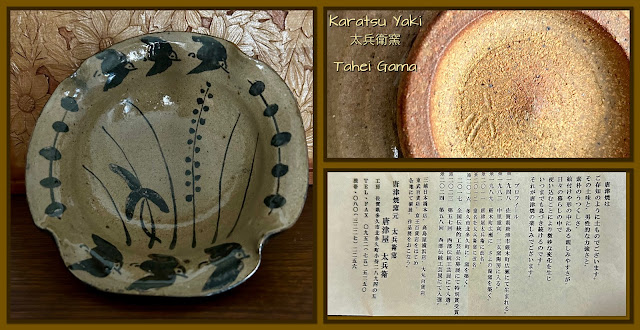Types of Karatsu Ware
E-garatsu (picture Karatsu)
Madara (speckled)
Ao Karatsu (blue)
Ki Karatsu (yellow)
Kuro (black )
Chosen (Korean style)
Hori Karatsu (carved)
Kohiki (White slipware)
Mishima (stamp/slip inlay)
| E-garatsu Generic Karatsu Mark (からつ) |
 |
| This is Kuro Karatsu or Black Karatsu ware, Nakazato Tarouemon-gama |
 |
| Pair of Yunomi by Nakazato Tarouemon 14 Gama |
 |
| This is the Nakazato Tarouemon MARK |
 |
| Nakazato Tarouemon kiln 14 Kiln papers |
Nakazato Taroemon Toubo tomobako mark close up
 |
| E-garatsu dipping dishes |
By Touyou 陶陽 The kiln is located in Fukuoka Prefecture on Itoshima.
We visited a wonderful shop just north of Karatsu station called Homura. The link for the store, although only in Japanese, is: http://www.karatsuyaki.com/. The sales staff were friendly and informative. I never knew there were so many types of Karatsu ware. The store carries wares from 35 kilns in the Karatsu area.
********************************
 |
| E-garatsu tea bowl, Ryuufukuji-gama |
 |
| Ryuufukuji-gama papers http://karatsuyaki-kamamoto.jp/english/pdf/65_ryufukujigama.pdf |
 |
| E-garatsu guinomi sake cup, Hinata-gama |
I love this one! This is by Hirayama Kenji of Nakanotsuji Gama
E-garatsu, Madara-garatsu, Chozen-garatsu, Mishima-garatsu, Kuro-garatsu, Ao-garatsu, Hori-garatsu, Mugi-garatsu, Hakeme-garatsu, Jakatsu-garatsu, Okugori-garatsu, seto-garatsu.
*************************************
Tokusawa Mitsunori works in Fukuoka but in the Karatsu tradition.


























